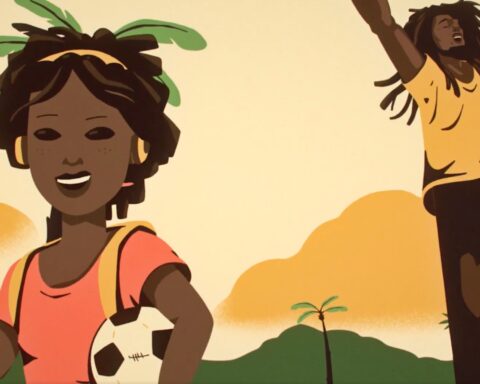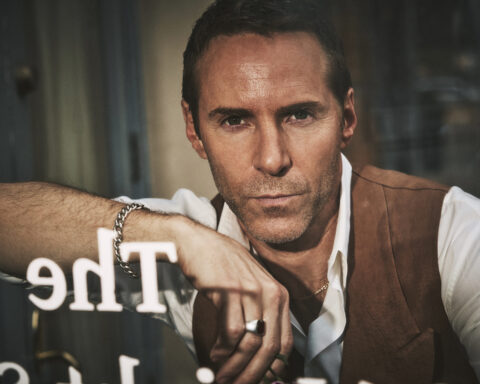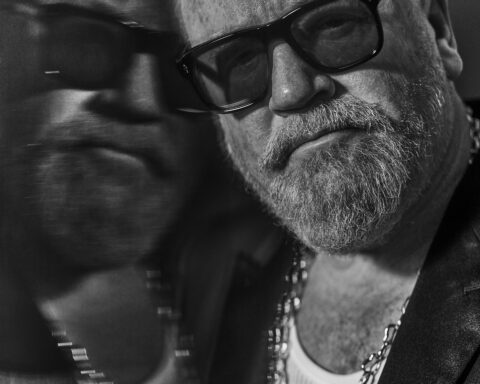Serial entrepreneur Jonathan Sposato is putting four decades of cutting edge technology and media experience into building JoySauce, the new digital lifestyle and culture destination for Asian Americans. Jonathan is the chairman and co-founder of PicMonkey, Geekwire, and more – and the only person to have built and sold two companies to Google. The father-of-one is also a man of great integrity, compassion, and kindness, whose lifelong mission to place inclusivity at the heart of his work shines through in his new venture. Here he describes a career spent at the intersection of technology, business, and creativity, and shares five tips to help the founders of the future.
By Jonathan Sposato
I’m a half Chinese, half Korean guy, who was born in London, with an Italian last name. I think my background gave me an interesting outsider’s perspective on being in the United States. It normalized being different, taking an unconventional path, and gave me thick skin – all of which helped in my business pursuits later in life.
I was born to a single mom, back in the late 1960s. She was Chinese and came to the US when she was 17, with a couple of hundred dollars in her pocket. She didn’t really have a plan, but she knew she wanted a better life. She went to New York University and became a nurse, and eventually went to work at Bellevue Hospital where she met a young Korean American doctor, and they fell in love. But when she got pregnant, they were not allowed to marry by their families, as the two cultures were very suspicious of each other at the time. So with her visa expiring, she went to work in London where she had some friends and relatives, and that’s where I was born. A few years later, we moved back to New York and lived in Brooklyn, where I spent most of my childhood. The Italian name came from my mom marrying a very nice Italian American man when I was nine. He was a former Vietnam veteran who had put himself through school, got a masters degree, and became a hospital administrator. He adopted me a few years later, and taught me how to play basketball, and all that good stuff. And despite the fact he and my mother have been divorced several decades now, I still consider him my dad.
I was a 4.0 student and a good athlete, but was closeted about being a computer geek for a long time. Personal computers were just emerging on the scene, but they weren’t very popular. When I was 13 or 14, I started writing computer games on an Apple II, and was able to sell them to bona fide games companies. I was being paid a princely sum of $25-an-hour as a high school kid, back in the early 1980s. And throughout college, I was working for computer companies, and had credits on games on the shelves. Despite this, I kept trying to leave the thing that I was good at. Although I displayed a propensity for making computer games, I never took it seriously and always thought I’d get a legitimate job one day. I decided to go to law school, but I soon realized that wasn’t work I was going to be very good at, so I didn’t end up going despite passing my entrance exam. I created my own games company instead. I thought it would just be me and three other buddies, and we would work on games together, but we very quickly grew to a fairly legitimate, large company with 43 employees. It was an incredible learning curve and my first time being a business owner, aged 23, and we ended up selling the company to Electronic Arts. I often say that experience was my graduate school.
In the late ‘80s and early ‘90s, the games industry was still seen as being very geeky and underground, and my nagging desire to get a legitimate job remained. That led me to work for Microsoft where I spent 12 years, the first six of which had nothing to do with games. I went into a division called Microsoft Research, where we did the most crazy, cutting-edge things; even then there was work in AI, image recognition, cool moonshot stuff. I had a great boss called Steve Arnold, who came over from LucasFilm, who put me on a project to visualize and create interactive TV. This was pre-internet, and we all thought the television was somehow going to merge with the computer for the next phase in entertainment. I was working on episodes of ‘Melrose Place’, turning that into a choose your own adventure show, and with producers on ‘Bill Nye the Science Guy’. And I remember fondly meetings with Steven Spielberg, Jeffrey Katzenberg, Ted Turner and Geraldine Laybourne. I was a young guy in his 20s, meeting with these heads of state, so I learned a lot about how you navigate and talk to execs at that level. The real humbling lesson here was that none of the interactive TV stuff panned out. It was too early and the infrastructure wasn’t there. But I learned it’s up to you how you cash in the work and ideas. I had colleagues who were devastated when these projects got canceled, but I looked at it all as great learning that I could apply to this new thing called the internet.

Jonathan Sposato // 📸 : Beau Grealy // Jonathan wears TOD’S cord jacket, cord pants. GUCCI cable knit cardigan, polo top. All jewelry, his own.
I haven’t always made the smartest career decisions. I remember, during the early days of internet 1.0, I did have some very shrewd colleagues, who said, ‘Hey Jonathan, I’m thinking that someday, people may want to buy their airline tickets over the internet. What do you think?’ And I’m like, ‘Oh, Rich, nobody would want to do that. I think I’d always want to talk to a travel agent.’ And of course, that was my friend Rich Barton, who went on to found Expedia. So there were a handful of these really smart people who left Microsoft, and walked away from really fantastic stock options and benefits, to be very entrepreneurial back in the late ‘90s. They saw everything starting to come together, and I did not see it yet. So I stayed at Microsoft, went back to my gaming roots, and was one of the very first people on the original XBox project. You learn so much making games. You’re creating experiences that are highly immersive. One of the best game designers that I ever worked with, a guy named Bruce Shelley who was behind the game ‘Age of Empires’, told me my only job as a game designer is to always make sure that every second, there’s a set of really interesting choices that the player has to make. That’s incredible insight that I have applied to everything that I do. Whether it is a web experience, such as Picnik or PicMonkey, the online photo editing services I co-founded, or a new site I’m creating, like GeekWire or JoySauce, I always want to give users a lot of different choices, rather than sending them down a narrower, linear path.
I’m glad that I worked in games at a time when they were still relatively elegant, and simple. And it was before things got really violent and bloody, and then that became the draw. I started to think about leaving the gaming industry and Xbox the day the Columbine High School shooting happened in 1999. I know that there was a lot of debate at the time about whether video gaming contributed to these kids going on a violent spree, and there’s no scientific evidence to suggest that it did. But in my heart, I knew that we were making some sort of indirect impact on society, and making violence entertaining.
So after 12 years, I quit Microsoft, and started a company called Phatbits, which was a platform for the creation of widgets that would sit on your desktop and do a bunch of cool things. I was able to sell that company to Google, who are the gold standard in the world of mergers and acquisitions. They move fast, don’t mess around, make the deal terms simple, and make it pretty founder friendly. I later sold a second company to Google, the photo editing service Picnik, which was 90% of Photoshop in 10% of the time. In both cases, we were little upstarts, but it’s a wonderful time to do business on the internet. If you have the better idea people will vote with their mouse clicks, it doesn’t matter if you’re a multibillion dollar company or not.
My next project, JoySauce, came out of the fact that growing up, I would turn on the TV and I didn’t see a lot of American Asian representation, people who looked like me. (We like to flip the term and say American Asian rather than Asian American. It distinguishes someone like myself, from say, someone who’s living in Taiwan. And it shifts the center of gravity to the Asian part, so American is the modifier.) I always wanted to do an American Asian centered media platform where we could see TV shows, podcasts, films, graphic novels, or thought-provoking written editorial, all in one place. The sites that I enjoy very much are ones where you’re choosing what you’re consuming, agnostic of whether it’s a video clip, or audio, or something written. So that’s what I want to do with JoySauce. Our mission is to increase American Asian representation in popular media, where portrayals of American Asians are positive, flattering, beautiful, funny, strong, cool, and nuanced. Today, with the anti-Asian hate crimes that are going on and a lot of other things, it still feels like as a group, we’re not quite there, and still somewhat marginalized. And maybe we could have a bigger seat at the table.
There are proportionately very few American Asians in entertainment. I think that’s because it’s important for a lot of American Asians to go into ‘legitimate’ fields. There’s that word again, legitimate, that followed me throughout my career. There’s a giant sea of talent out there, and I want to harness that.

Jonathan Sposato // 📸 : Beau Grealy // Jonathan wears TOD’S cord jacket, cord pants. GUCCI cable knit cardigan, polo top. All jewelry, his own.
Here are Jonathan’s five tips for entrepreneurs
1. Don’t believe in the myth of ‘first mover advantage’. Just because you are the first to think of and to execute on a new idea, doesn’t mean you will have instant success and dominate the new segment. Oftentimes, the first movers don’t get it quite right and it’s the second or third wave folks who learn from those earlier mistakes to achieve success.
2. The above cuts both ways. Just because you’re not the first, doesn’t mean you can’t catch up. Take a look at the first wave guys to see what they missed, or how the model can be improved upon. Arguably I’ve had much more success being part of a second wave. Maybe you’re six months behind someone else, but it does not mean you can’t be better. Play the long game!
3. Hire the best people you can afford and get out of their way. The difference between B players and A players is startling. A players are not just 20% or 25% better than B players, they are probably closer to 100% to 200% better if you measure how much time they can save you, multiplied by the number of direct reports you may have as a CEO. It’s usually the case that you aren’t able to afford to pay top dollar, but hopefully you can make it up in other ways; build a mission driven company, create a great culture, be a great boss, and, of course, skin in the game in the form of equity.
4. A small percent of a super large pie can be just as good as dominating a newer small pie. And for sure know the difference. The first requires a strategy to show up with a better mousetrap and exploit the value gap between incumbent solutions and how users are shifting behavior. The second requires a different strategy and it’s inherently more risky. Both are risky, but the second is much harder in my own experience. The only wrong move is to not know.
5. Don Norman’s concepts of ’emotional design’ apply throughout your entrepreneurial journey. The basic concept is that people will be more delighted, and consequently loyal to your product, if you can forge an emotional connection with them. He really meant for his book to apply to physical products, but I have found this to apply equally to your company’s brand, how you communicate to users, how you lead as a CEO, and of course how you design your app or website. You don’t have to be an expensive car or gorgeous sofa for these concepts to apply. Ways of forging an ’emotional connection’ with users on the internet can be through the use of humor, storytelling, as well as game design principals where you may surprise and delight folks unexpectedly. I think Mr Feelgood is itself a fantastic example of following the concepts of ’emotional design.’ Your endorphins fire when you read the well-written editorial, see the wonderful photography, and you end up learning and feeling enriched by the super interesting people. In other words, it makes you feel good! And that’s the ultimate form of ’emotional design.’

Jonathan Sposato // 📸 : Beau Grealy // Jonathan wears TOD’S cord jacket, cord pants. GUCCI cable knit cardigan, polo top. All jewelry, his own.
Jonathan was speaking to Mr Feelgood’s Pete Samson.
JoySauce launches on April 28, 2022. Check out the site here.











